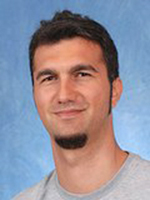UNC scientists expand the use of light to control protein activity in cells. Klaus Hahn and Nikolay Dokholyan have published a paper in Science, detailing how they use light- or ligand-sensitive domains to modulate the structural disorder of diverse proteins, thereby generating robust allosteric switches. The title of the paper is “Engineering extrinsic disorder to control protein activity in living cells.”

The work, led by Klaus Hahn, PhD, the Ronald Thurman Distinguished Professor of Pharmacology, and Nikolay Dokholyan, PhD, the Michael Hooker Distinguished Professor of Biochemistry and Biophysics, both in the UNC School of Medicine, builds on the breakthrough technology known as optogenetics. The technique, developed in the early 2000s, allowed scientists, for the first time, to use light to activate and deactivate proteins that could turn brain cells on and off, refining ideas of what individual brain circuits do and how they relate to different aspect of behavior and personality.
But the technique has had its limitations. Only a few proteins could be controlled by light; they were put in parts of a cell where they normally didn’t exist; and they had been heavily engineered, losing much of their original ability to detect and respond to their environment.

In their new work, spearheaded by UNC graduate student Onur Dagliyan and published in Science, the researchers expanded optogenetics to control a wide range of proteins without changing their function, allowing a light-controllable protein to carry out its everyday chores. The proteins can be turned on almost anywhere in the cell, enabling the researchers to see how proteins do very different jobs depending on where they are turned on and off.
“We can take the whole, intact protein, just the way nature made it, and stick this little knob on it that allows us to turn it on and off with light,” said Hahn, Thurman Distinguished Professor of Pharmacology. “It’s like a switch.”
The switch that Hahn, Dokholyan and colleagues developed is versatile and fast – they can toggle a protein on or off as fast as they can toggle their light. By changing the intensity of light, they can also control how much of the protein is activated or inactivated. And by controlling the timing of irradiation, they can control exactly how long proteins are activated at different points in the cell.
Because the tools keep the natural protein function intact, the new technique allows scientists to study proteins in living systems, where proteins normally live and work in all their natural complexity. This ability to manipulate proteins in living systems also provides an opportunity to study a wide range of diseases, which often arise from the malfunctioning of a single protein.
(~The above paragraphs are excepts from a UNC School of Medicine Newsroom article by by Thania Benios. Read the full article here: “Optogenetics Breakthrough: UNC scientists expand the use of light to control protein activity in cells.”)
Abstract
Optogenetic and chemogenetic control of proteins has revealed otherwise inaccessible facets of signaling dynamics. Here, we use light- or ligand-sensitive domains to modulate the structural disorder of diverse proteins, thereby generating robust allosteric switches. Sensory domains were inserted into nonconserved, surface-exposed loops that were tight and identified computationally as allosterically coupled to active sites. Allosteric switches introduced into motility signaling proteins (kinases, guanosine triphosphatases, and guanine exchange factors) controlled conversion between conformations closely resembling natural active and inactive states, as well as modulated the morphodynamics of living cells. Our results illustrate a broadly applicable approach to design physiological protein switches. (~ abstract from Dagliyan, et al., Science, 354(6318): 1441-1444.)
The full citation for the paper is: Dagliyan, O., Tarnawski, M., Chu, P-H., Shirvanyants, D., Schlichting, I., Dokholyan, N.V., and Hahn, K.M. Engineering extrinsic disorder to control protein activity in living cells. Science, 354(6318): 1441-1444, 2016.
For a free link to the article in Science online go to the Hahn lab publications page
January 12, 2017 – This article has been updated to include excerpts from the UNC School of Medicine’s press release.
